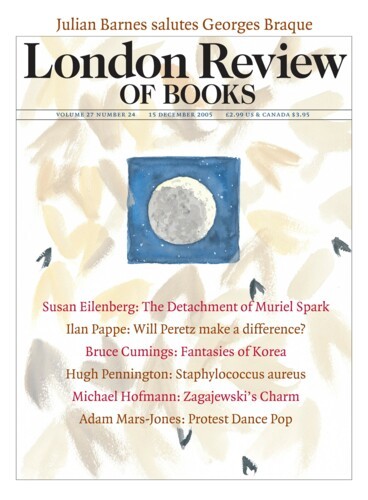It’s the time of year when the kinds of thing that are done with light are very like those which, if done with a spray-can, would have boys up in front of the magistrates. Above Regent Street there is a parade of panels peppered with blue lights. Large snowflakes flick on and off. Cut-outs of a cartoon sabre-tooth tiger, mammoth and sloth advertise the cartoon Ice Age 2: The Meltdown – even light needs a sponsor. Is the graphic style of cheap wrapping-paper really the best that shopkeepers who cherish their brands like jealous husbands can do for their flagship stores?
Electric graffiti spreads. Humble buildings are swathed in strings of little lights like bunting. The same little lights infest city trees like a plague of monster glow-worms, and do it not only at Christmas: for lights, like fireworks, now know no season. Perfectly decent buildings are draped with flashing bulbs like the girls you see leaving office parties draped in tinsel.
It may be that CCTV cameras need every alley to be well-lit if they are to provide the blurred images that have replaced film noir stereotypes in the iconography of villainy, but it means that one can now only imagine the wonders of the dangerous world that floodlighting and streetlighting, the combined muzak and traffic noise of the visual environment, have taken from us.
The best obituary for a dusky pre-electric world that I know is Junichiro Tanizaki’s wonderful essay In Praise of Shadows, written in 1933. He describes how the virtues of traditional Japanese rooms depended on ‘variation of shadows, heavy shadows against light shadows’; how ancestors, ‘forced to live in dark rooms, presently came to discover beauty in shadows, ultimately to guide shadows towards beauty’s ends’. He wonders whether the blackened teeth and shaved eyebrows of traditional Japanese courtesans were not also a response to lives lived in the shade where a pale face and pale hands were all that you saw:
Our ancestors made of a woman an object inseparable from darkness, like lacquerware decorated in gold or mother-of-pearl. They hid as much of her as they could in the shadows, concealing her arms and legs in the folds of long sleeves and skirts, so that one part and one only stood out – her face.
Bright light does not discover, but drives away beauty. A moon-watching picnic on the lake is destroyed by the electric light on the shore. Kabuki theatre becomes crude when white faces and gaudy costumes are flooded with light. The force of Tanizaki’s elegy for the old is made the more powerful by his perception that the new is unavoidable: he describes the problems he had building a new house, how convenience and a modern taste for the demonstrably hygienic defeated the old ways. Although, he says, ‘anyone with a taste for traditional architecture must agree that the Japanese toilet is perfection,’ he turns in the end to white tiles and running water, while finding it ‘crude and tasteless to expose the toilet to such excessive illumination’. Three-quarters of a century later, we have our own losses to catalogue. The sense of great scale and solemnity that goes with being close to an unlit cathedral at night is now possible only if there is a power cut. In open country it is almost impossible to be so far from the glow of populated horizons that just stars and the moon light the scene. Moonlight has been lost as a subject that draws on shared experience. The notion that the Lunar Society chose to meet on nights of the full moon so that members might see their way home is as foreign to our experience as their wigs and breeches.
More significant architecturally is the damage done to buildings designed to be seen by the shifting light of day (sometimes bright, sometimes flattened by cloud, low in the morning and evening, high at noon, varying from season to season and hour to hour, but always coming from above or from the side) when they are subject to unflinching floodlighting from below. Think how you would feel about the performances of an actor who had to do half of them with a torch held under his chin.
An exhibition of photographs of lighting on London buildings set up by New London Architecture both challenges and confirms photophobia. Like their engrossing 1:15000 scale model of London, it is to be seen at the Building Centre, 26 Store Street. A few illuminations have the authority of the best minimalism: I will look out for the laser beam which shines from the Greenwich Observatory along the line of 0° longitude. Projecting pictures onto the horrid buildings of Croydon (‘potentially dull’, the catalogue has it; they are much worse than that) is probably no huge annoyance but, judging by the example shown, it is no great pleasure either. The fashion for running lines of LEDs over paving may, in Finsbury Avenue Square, have transformed a ‘staid business square into a piece of dancing magic’. Now that ‘staid’ is not the routine epithet for businessmen that it once was, the installers of the LEDs may have matched environment to occupants. The fibre optics lighting the fountain at Somerset House are very pleasing (although I’d rather they didn’t change colour), but as for the lighting of William Chambers’s façade, the description ‘sensitive’ here means making the most of an impossible job.
Thinking about too much light brought to mind the first line of Paul Simon’s old song ‘The Sound of Silence’: ‘Hello darkness my old friend’. I dug out the LP and found I’d forgotten a couplet from its far from lucid lyrics:
And the people bowed and prayed
To the neon god they made.
We’re heading that way.
Send Letters To:
The Editor
London Review of Books,
28 Little Russell Street
London, WC1A 2HN
letters@lrb.co.uk
Please include name, address, and a telephone number.

